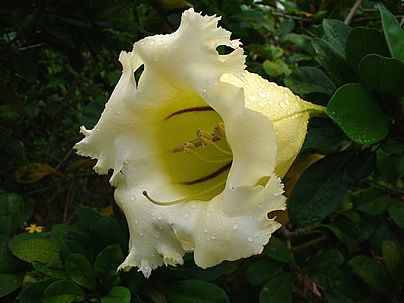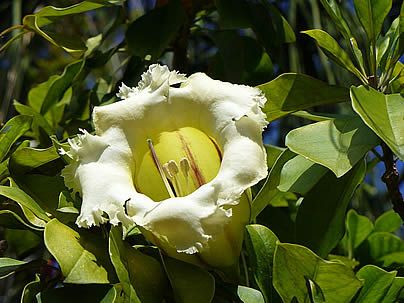The chalice vine (Solandra grandiflora) is a climbing or sprawling shrub, woody, with ornamental foliage and flowering, still rare in cultivation. It is native to the Americas, mainly from tropical to high-altitude tropical regions of Mexico, the Caribbean, and South America. Its branches are long, vine-like, interspersed with nodes, from which branches and adventitious roots emerge, assisting the plant in its fixation and nutrient absorption. The leaves are oval, bright green, with short petioles, of a leathery to membranous texture, glabrous, simple, about 4 inches (10 cm) in length.
It flowers in spring, revealing large, solitary, terminal, bell-shaped flowers, ranging in color from cream yellow to golden yellow, with brownish rays and long stamens. The flowers have the corolla fused at their base and body, with recurved tips. At the end of the day and at night, the flowers release a fragrance reminiscent of coconut, attractive to bats, their pollinators. The fruits that form are berries, white to yellow in color, with numerous small seeds.

The chalice vine prefers ample space and strong structures for its splendid development. Initially, the branches are erect and can be pruned to make the plant full and dense, thus maintaining a shrubby stature. As it grows, it becomes sprawling, leaning on the support provided. Therefore, use it to cover dead trees, fences, trellises, pergolas, arches, or arbors, with ties if necessary.
This is a large, leafy, and heavy vine, so avoid using it on delicate supports. It admits drastic pruning from time to time to control its growth, but wear gloves, avoiding contact with the plant’s sap, which can cause skin and mucous membrane irritation. It is a species that adds a tropical and wild touch to landscaping, but it is still hard to find in nurseries. It can be planted in pots.
Curiosity: The chalice vine is used by shamans and medicine men in magical indigenous rituals in Central and South America. However, due to its reserved use for black magic and other obscure and secretive purposes, little is known about its uses. These magical uses are possibly related to its tropane alkaloid content, and consequent hallucinogenic and toxic potential of this plant. Both the Mayas and the Aztecs considered it sacred.
It prefers full sun, fertile, well-drained soil, enriched with humus, and regularly irrigated during the first years of establishment. Tolerant to short periods of drought. It does not tolerate frost. Fertilize monthly during vegetative growth and flowering. Propagated by cuttings, layering, and seeds.


